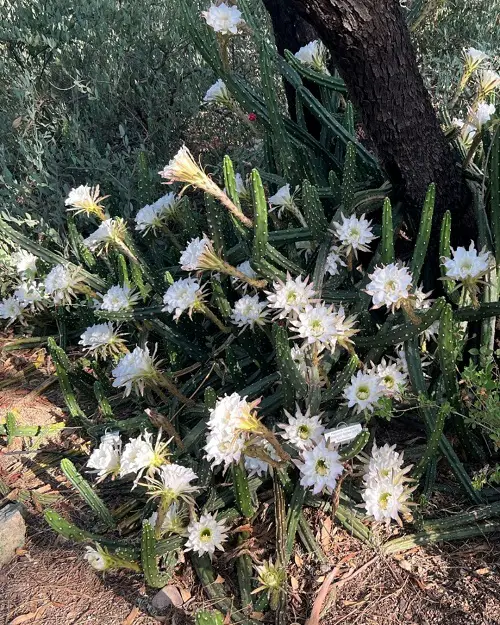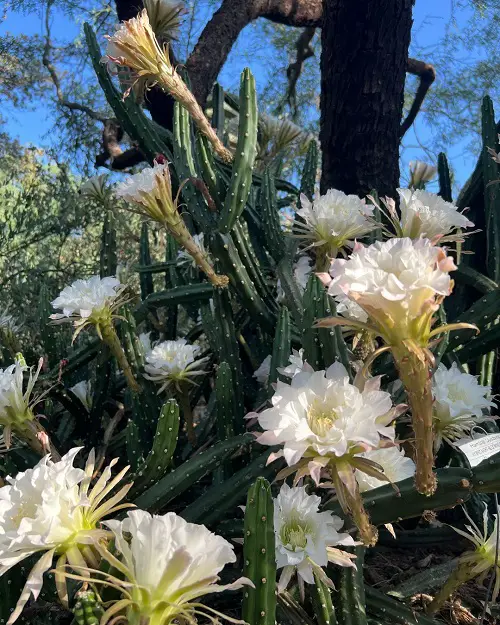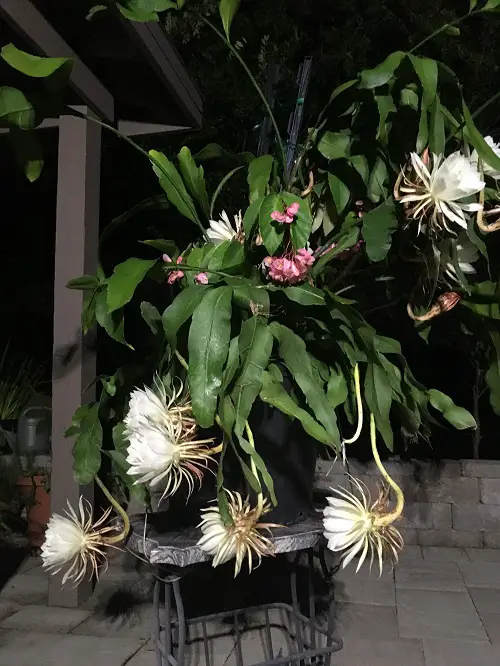Making Queen of the Night flower is no easy task. Follow our guide to learn How to Get Night Blooming Cereus to Bloom!

What makes this cactus really special is the fact that it flowers only for the night! If you have it in your collection and want to make sure it blossoms, then follow our guide on How to Get Night Blooming Cereus to Bloom.
Night Blooming Flowers
There are different types of Night Blooming Cereus that you can grow. All of them bloom fragrant flowers in the night. Some of the best ones are:
1. Epiphyllum oxypetalum – The Dutchman’s Pipe
- Bloom Time: Typically blooms late spring to early summer, often after rainfall.
- Duration: The flower opens at night and lasts for just one night. By morning, the bloom starts to fade.
2. Hylocereus undatus – Dragon Fruit Cactus
- Bloom Time: Flowers generally appear from summer to early autumn, depending on the climate and conditions.
- Duration: Like many cacti of its kind, it blooms at night, and the flowers begin to wilt by early morning.
3. Cereus jamacaru – Cardeiro
- Bloom Time: Blooms in the warmer months, typically from late spring to summer.
- Duration: This cactus blooms at night and, similar to the others, the flowers begin to fade by the next morning.
4. Epiphyllum ‘Fifty Grand’ – Red Orchid Cactus
- Bloom Time: Generally in the late spring to early summer.
- Duration: The flowers last for several days, making it a bit unique among the Epiphyllum genus.
5. Epiphyllum ‘Thousand Pinks’ – Pink Orchid Cactus
- Bloom Time: It blooms from late spring to early summer.
- Duration: Like ‘Fifty Grand,’ the blooms on this cultivar typically last for a few days.
6. Epiphyllum hookeri – Hooker’s Orchid Cactus
- Bloom Time: Late spring to early summer.
- Duration: The nocturnal flowers remain open from evening until early morning and then close, lasting for just a single night.
How Night Blooming Cereus is Different From Other Night Blooming Cactus
Night-Blooming Cereus is a common name that refers to several different cacti species that bloom at night. However, when many people say “Night-Blooming Cereus,” they are typically referring to Epiphyllum oxypetalum or Selenicereus grandiflorus. While there are several night-blooming cacti species, each has distinct characteristics that differentiate them.
Here are some points that show how Night-Blooming Cereus (Epiphyllum oxypetalum or Selenicereus grandiflorus) is different from other night-blooming cacti:
1. Origin and Habitat:
-
- Epiphyllum oxypetalum: Originates from Central and South America and is epiphytic in nature, often growing on trees.
- Selenicereus grandiflorus: Native to Central America and the Caribbean.
- Other night-blooming cacti can have different origins, like the desert regions of the U.S. and Mexico.
2. Growth Habit:
-
- Night-Blooming Cereus typically has long, flat, leaf-like stems or slender, vining stems.
- In contrast, other night-blooming cacti might grow as columnar cacti or have rounder stems.
3. Flower Size and Appearance:
-
- The flowers of Epiphyllum oxypetalum are large, often spanning 6-8 inches or more, and are pure white.
- Selenicereus grandiflorus also has large, fragrant flowers but may have a slightly different appearance with a more yellowish center.
- Other night-blooming cacti might have smaller flowers or exhibit different colors or patterns.
4. Bloom Duration:
-
- The flowers of Night-Blooming Cereus typically open after sunset and wilt by early morning. They often bloom only once a year, and the individual flowers last just one night.
- Some other night-blooming cacti might have flowers that last several nights or have multiple blooming episodes throughout a season.
5. Scent:
-
- Night-Blooming Cereus flowers emit a strong, sweet fragrance to attract nighttime pollinators.
- While many other night-blooming cacti are also fragrant, the intensity and exact scent can vary among species
Here are Amazing Cactus with Arms
Most Common Mistakes that Stops Night-Blooming Cereus to Flower

- Overwatering: Just like other cacti, Night-Blooming Cereus doesn’t like to sit in wet soil. Overwatering can lead to root rot, which can inhibit blooming and even kill the plant.
- Insufficient Light: Although they don’t like direct afternoon sun, these plants still need bright indirect light. Without adequate light, they may not have enough energy to produce flowers.
- Excessive Feeding: Over-fertilizing, or using a fertilizer with the wrong nutrient balance, can lead to lush growth at the expense of blooms.
- Lack of Temperature Differential: These plants thrive on a noticeable temperature drop at night. Without this differential between day and night temperatures, blooming might be affected.
- Repotting at the Wrong Time: While it’s necessary to repot plants occasionally, doing so close to their blooming period can stress the plant and disrupt the flowering process.
- Keeping the Plant Too Comfortable: Plants often bloom in response to slight stress as a survival mechanism. If the Night-Blooming Cereus is always in optimal conditions without any change, it might not feel the need to reproduce, meaning it won’t flower.
- Improper Pruning: Incorrect pruning or trimming the plant during its budding stage can result in the loss of potential flowers.
- Pest and Disease Pressure: A plant under stress from pests or diseases will prioritize survival over reproduction, which can inhibit blooming.
- Lack of Patience: Some plants simply take time to mature enough to start flowering. If the plant is young or was propagated recently, it might just not be ready yet.
- Unsuitable Soil: Using soil that doesn’t provide proper drainage can prevent roots from breathing and deter flowering.
- Lack of Humidity: While they are drought-tolerant, they still appreciate some humidity. In very dry environments, a lack of moisture can prevent buds from forming.
- Moving the Plant Often: Frequently changing its location, especially if light and temperature conditions differ drastically, can stress the plant and affect blooming.
Secret Tips on How to Get Night Blooming Cereus to Bloom?
The Night Blooming Cereus, sometimes referred to as the “Queen of the Night,” is a captivating cactus that blooms only at night, revealing large, fragrant flowers. Getting the Night Blooming Cereus to bloom and prolonging the blooming time can be an exciting challenge. Here are some expert tips, secrets, and even unconventional ways to help you achieve this:
1. Provide Optimal Growing Conditions:
- Sunlight: Place the plant in a location where it receives bright but indirect sunlight.
- Soil: Use well-draining, sandy soil. A cactus or succulent soil mix will typically work well.
- Watering: Water the plant regularly during the growing season but allow the soil to dry out between watering.
2. Create a Fertilization Schedule:
- Regular Feeding: During the growing season, use a balanced fertilizer, ideally a cactus-specific formula, every 2-4 weeks, after diluting it to 1/2 of its recommended strength. This provides essential nutrients that can stimulate blooming.
3. Manipulate Light Exposure (Unconventional Trick):
- Evening Shade: Consider shading the plant during the late afternoon and early evening. The sudden change from bright daylight to shade can mimic the desert conditions, potentially triggering blooming.
4. Utilize Scent (Secret Trick):
- Use Fragrant Companions: Some growers believe that placing fragrant plants or flowers near the Night Blooming Cereus can encourage it to bloom. The idea is that the scents might stimulate the plant to produce its own fragrance.
5. Prolong Blooming Time (Unconventional Method):
- Ice Cubes: Placing 2-4 ice cubes around the base of the plant in the evening can cool the roots and may prolong the blooming time by slowing down the opening process. This creates a more gradual temperature change, replicating desert conditions.
6. Stress the Plant (Secret Trick):
- Controlled Under-Watering: Slightly stressing the plant by reducing watering (Watering 4-5 days after the topsoil feels a little dry to the touch) can sometimes encourage blooming, as the plant may attempt to reproduce (bloom) in response to the perceived threat to its survival.
Note: Be cautious not to overdo this, as excessive stress can harm the plant.
7. Prune Properly:
- Remove Dead Growth: Keeping the plant well-pruned by removing dead or damaged growth encourages healthy development and can stimulate blooming.
8. Maintain Proper Temperature:
- Cool Nights: Night Blooming Cereus prefers cooler night temperatures, so make sure to provide a nighttime drop in temperature if you are growing it indoors.
9. Music Stimulation (Highly Unconventional):
- Play Classical Music: Some plant enthusiasts swear by playing soft classical music to their plants. While scientific evidence is limited, some believe that gentle vibrations can positively influence growth and flowering.
10. Patience and Observation:
- Take Notes: Keeping a blooming journal with dates, weather conditions, and care routine can help you discover what specific triggers cause your Night Blooming Cereus to bloom.
Remember, the Night Blooming Cereus is known for its unpredictability, and part of the allure is the surprise and rarity of its bloom. Experiment with these tips, and be patient; the breathtaking bloom is well worth the wait!
How to Force African Violets to Bloom Better and Fuller
Winter Care

- Temperature: Ensure that the plant is kept in a space where temperatures remain above 50°F (10°C). It’s sensitive to frost and extreme cold.
- Light: Provide bright, indirect light. Even though growth slows during winter, adequate light helps maintain plant health.
- Watering: Reduce watering frequency in winter since the plant enters a semi-dormant state. Water only when the topsoil feels dry.
- Humidity: If the air in your home is extremely dry during winter, consider using a humidity tray or room humidifier to provide some ambient moisture.
- Position: If your plant is in a drafty window, consider moving it to a location away from cold drafts and sudden temperature changes.
- Fertilization: Avoid fertilization in winter, as the plant isn’t in its active growth phase.
- Pest Inspection: Periodically inspect for pests like spider mites, which might be attracted to indoor plants during winter.
- Pruning: Refrain from heavy pruning in winter. If necessary, remove only damaged or dead stems.
- Repotting: Delay repotting until early spring when the plant starts its active growth again.
- Protection: If your Night-Blooming Cereus is outside for any reason, ensure to bring it inside before the first frost.




